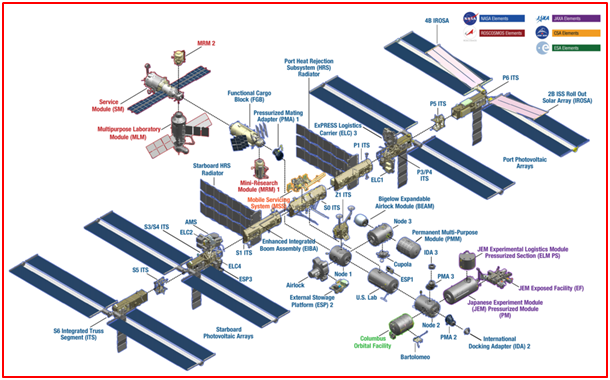

Context
Russia recently announced that it will withdraw from the International Space Station (ISS) project after 2024, signalling an end of an era in one of the last remaining areas of cooperation between Russia and the United States.
About
About International Space Station:
- A space station is essentially a large spacecraft which remains in low-earth orbit for extended periods of time.
- The International Space Station is the only operational space laboratory as of now.
- It is orbiting the earth in a trajectory that is about 400 km above the land surface.
- It is like a large laboratory in space, and allows astronauts to come aboard and stay for weeks or months to carry out experiments in microgravity.
- The ISS has been in space since 1998, and has been known for the exemplary cooperation between the five participating space agencies that run it: NASA (United States), Roscosmos (Russia), JAXA (Japan), ESA (Europe), and CSA (Canada).
- It completes one journey around the earth in about one and a half hours. In one day, therefore, it makes about 16 trips around the world.
- At any given time, there is a crew of six astronauts on board. Right now, seven astronauts, four from the United States, two from Russia (it prefers to call them cosmonauts) and one from Germany, are at ISS.
- The facility is used for carrying out a variety of zero-gravity experiments, space exploratory studies, and technology development.
- The ISS is not the first space station to be built and operated.
- Several smaller space stations have been used earlier, the most famous of which have been the Russian Mir space station that operated in the 1980s, and the American Skylab.

The complexity of cooperation:
- One of the most complex engineering projects ever attempted, the International Space Station is made up of two primary segments, one managed by NASA and the other by Roscosmos.
- The S. segment, as it's known, features four huge NASA-supplied solar wings, two on each end of a truss as long as a football field, complex cooling systems, computer networks, high-speed communications systems and 10 pressurized modules
- The U.S. segment also features four docking ports that can accommodate Northrop Grumman Cygnus cargo ships, Japanese HTV freighters, SpaceX Dragon crew and cargo ships and Boeing's Starliner crew ferry craft.
- The back section of the station, made up of six pressurized compartments, is operated by Four Russian docking ports are currently used by Progress cargo ships and Soyuz crew ferry vehicles.
- One of those, known as Zarya, connects the U.S. and Russian segments.
- It was paid for by NASA but is operated by Russia.
- Russia provides the propellant and thrusters needed to keep the outpost in orbit while NASA provides most of the station's electrical power, satellite communications and day-to-day stability provided by four massive gyroscopes.


